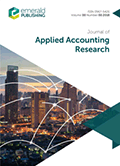|
Autores/as
Ravenda, Diego; Valencia-Silva, Maika Melina; Argiles-Bosch, Josep Maria; García-Blandón, Josep
|
Abstract
Purpose: This paper develops novel proxies for labour tax avoidance (LTAV) and tests their validity within a sample of 189 labour tax-avoidant offending firms (LTAOFs) accused of evading social security contributions (SOCs) by public authorities. Design/methodology/approach: LTAV proxies are based on abnormal values of SOCs paid, reported in the income statements of a sample of 857,790 Spanish firm-years for the period 2001–2015, estimated through two-stage least square panel data regressions with firm fixed effects. Findings: The results reveal that proxies specifically built to signal both conforming and non-conforming LTAV can provide evidence of abnormally low SOCs as expenses within the sample of LTAOFs. Furthermore, firm-specific financial variables as well as macroeconomic variables significantly influence LTAV. Research limitations/implications: This study could foster further research on the efficacy of the LTAV proxies and on the drivers and sustainability implications of LTAV for firms and their stakeholders in different socio-economic and institutional contexts. Practical implications: These LTAV proxies could integrate other methods applied to estimate the undeclared work and its trends. Furthermore, they may assist tax authorities to direct their inspections, detect labour tax evasion and then strengthen the social protection of the employees from employers' illegal exploitation practices, as well as reducing tax revenue shortfalls and related sustainability concerns in the social security systems. Originality/value: This study proposes a novel methodology to examine LTAV and its determinants through accounting information. This methodology may support researchers to provide a more comprehensive picture of tax planning strategies pursued by companies, that include LTAV, and in this way integrate the extant mature literature on income tax avoidance.
|

WoS
Scopus
Altmetrics
 
|
|
Publicación
Journal of Applied Accounting Research, 6 June 2020, v.21, n.3, p.477-496
|
